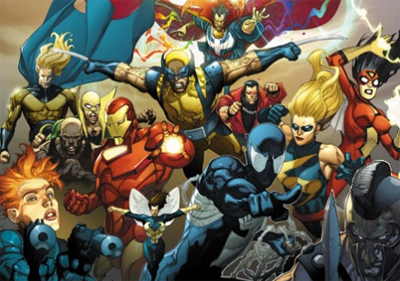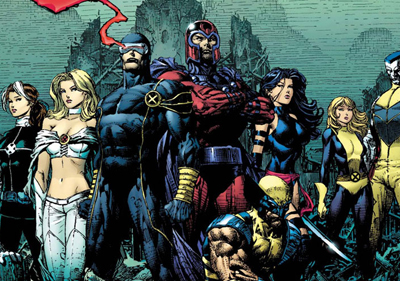In August, I decided it would be… interesting to take a look at the event-driven storylines that Marvel was producing between 2005 and 2010. So, for sixteen weeks (and more, if you consider the occasional bonus back-up feature), I reviewed one of the many “events” Marvel produced during the period. I’ve grouped the particular strands of continuity together below for easy of browsing (also providing the original date of publication). I hoped that exploring this particular aspect of the medium might grant me some insight into why big events like this continually upset on-going stories being told by writers in individual characters’ books. It was an interesting experiment, even if I doubt I’ll be engaging with the core of the Marvel Universe so thoroughly any time soon.
Note: It is incomplete. I had planned to follow The Avengers through to Siege, but it looks like my reviewing schedule caught up with them – for the same reason I haven’t got around to The Thanos Imperitive yet. I will return to this thread in the future.
Avengers-Based Continuity
It was a good decade for The Avengers as a franchise, with Marvel consciously pushing the franchise to the forefront – not just in comics but in other media as well. If the nineties and early naughties belonged to the X-Men (with X-Men: The Animated Series on the airwaves, Bryan Singer’s X-Men in cinemas and crossovers like Age of Apocalypse in comic books), this was very clear attempt to take that back. Brian Michael Bendis was tasked with turning the Avengers into Marvel’s prime franchise and succeeded – most of the “big” comic book events of the decade revolved around them. That said it was certainly a controversial restructuring of the book, with a line-up crafted to feature more popular characters like Spider-Man and Wolverine instead of more obscure characters like Quicksilver or the Scarlet Witch.
The Avengers branched out into other media too. Iron Man demonstrated that Marvel’s “big three” could hold viewer interest in cinemas, and promised a series of crossovers on the big screen that would see The Avengers assemble under the direction of Joss Whedon. As a brand, Marvel made sure these characters were everywhere.
The stories featuring these characters over the decade form something of a larger meta-story which seems to reflect on the superhero genre as a whole. Although Bendis’ New Avengers opens with a supervillain breakout, the characters spent more time fighting each other than bad guys (Civil War, World War Hulk). When they did fight bad guys, they were more often than not corrupted mirrors of themselves, be it the Skrulls who had managed to so perfectly imitate heroes despite being villains (Secret Invasion) or government-sanctioned psychotic “Dark Avengers” (Siege). It was a story about how difficult it was to be a hero in the last few years – in the wake of the “dark age” of comic books – and a deconstruction of the effectiveness of a group of individuals like this to actually make a difference. You could even argue that this was a grim reflection of real world political and social uncertainty – particularly mistrust of authority (it’s telling how much time these heroes spend going “rogue”). Of course, this is open to interpretation, and many fans were less than pleased with the execution of this particular tale.
- On-Going “Avengers” Titles
- New Avengers
- Volumes #1-2 (Hardcover) (January 2005 – August 2006)
- Volumes #3-4 (Hardcover) (August 2006 – February 2008)
- Mighty Avengers
- Assemble & Secret Invasion (Hardcover) (May 2007 – February 2009)
- New Avengers
- Events
- House of M (August 2005 – January 2006)
- Civil War (July 2006 – January 2007)
- World War Hulk (July 2007 – January 2008)
- Prologue: Planet Hulk (April 2006 – June 2007)
- Secret Invasion (June 2008 – January 2009)
- Utopia (August – November 2009)
- Siege (March – May 2010)
“Cosmic Marvel” Continuity
Marvel’s Cosmic Universe got a much-needed revitalisation this decade, offering perhaps a better-plotted and more straightforward avenue for Marvel’s crossover events. Although Jim Shooter had done great work with many of these characters in the nineties (with Infinity Gauntlet and so forth), they had mostly remained in relative obscurity before the relaunch.
The distinguishing aspect of these stories is the way that they are structured. Rather than a big event coinciding with countless tie-ins across countless books, most of these stories would open with a single prologue issue which would branch into a handful of miniseries running for a set number of issues, before dovetailing into a main series. This meant that every issue remotely connected with a series could be collected in a hardcover. Admittedly the titles become more entangled in continuity as they went on (with War of Kings tying in directly to Ed Brubaker’s The Rise & Fall of the Shi’ar Empire story arc in Uncanny X-Men), but by and large these series served to avoid pointless tie-ins and an exceptionally convoluted continuity (everything you needed was included in the books themselves).
They’re the best crossovers that you weren’t reading.
- On-Going “Cosmic” Titles
- Nova
- Annihilation (June 2007 – June 2008)
- Nova
- Events
- Annihilation (November 2005 – May 2007)
- Annihilation: Conquest (August 2007 – June 2008)
- War of Kings (March – August 2009)
- Realm of Kings (January – May 2010)
- The Thanos Imperitive (August – November 2010)
X-Men Continuity
The last decade has been an interesting one for the X-Men, as both the books and the characters have found themselves looking for purpose. Grant Morrison’s New X-Men posited a world where mutants would be the dominant species with a few generations and proposed to move the “mutants as oppressed minority” metaphor firmly into the twenty-first century, where the worries weren’t (at least for the most part) about government-sponsored genocide or legal rights, but cultural and social questions about the way that mutants and humanity live together. This was clearly a step too far, as Marvel decided to essentially wipe out the mutant population, feeling there were too many mutants in the Marvel Universe. This was done with three words from a psychotic Scarlet Witch rather than a more subtle approach (like simply reducing the number of mutants featured in various books).
Suddenly the X-Men found themselves facing extinction, and this became a driving narrative force for the book. It was as if the line was actively rebelling against the editorial mandate forced upon them. Instead of granting narrative clarity, the edict had instead complicated things. It also forced the X-Men away from their widely-loved position as a civil rights metaphor and towards a more straight forward “find the cure” narrative. It also served to isolate the franchise from the rest of the Marvel Universe (except for Wolverine, of course, who is everywhere) – the X-Men were always busy doing their thing and trying not to die out rather than assisting with Civil War or Secret Invasion. The solution to this narrative thread is entirely predictable, but it does offer a clear structure to the X-Men stories from the period.
It’s interesting to note that while all the major Avengers titles from this period (New/Mighty/Dark Avengers) have been consistantly collected, the X-Men books have not been. Ed Brubaker’s run is quite difficult to collect in one consistent format, as is Matt Fraction’s – and both are writing for what should be “the flagship book” of the X-Men publishing line, Uncanny X-Men. This makes it considerably harder to follow than the Avengers franchise, for example.
- On-Going “X-Men” Titles
- New X-Men
- New X-Men by Grant Morrison Omnibus (July 2001 – June 2004)
- X-Force
- Famous, Mutant & Mortal (May 2001 – August 2002)
- Astonishing X-Men
- Astonishing X-Men by Joss Whedon & John Cassidy Omnibus (July 2004 – March 2008)
- Uncanny X-Men
- The Rise and Fall of the Shi’ar Empire (September 2006 – July 2007)
- Nation X (September 2009 – March 2010)
- New X-Men
- Events
- House of M (August 2005 – January 2006)
- Messiah Complex (October 2007 – January 2008)
- Messiah War (May – July 2009)
- Utopia (June – August 2009)
- Second Coming (March – July 2010)
Filed under: Comics | Tagged: avengers, brian michael bendis, bryan singer, comic book crossovers, comic book events, continuity, crisis, crossovers, joss whedon, marvel, marvel comics, Scarlet Witch, World War Hulk |


























Very excited about the Joss Whedon “Avengers” film – I’ve been reading his “Astounding X-Men” run a lot recently. I’m hoping it’s based largely on the “Ultimates” texts, as the casting of Jackson as Nick Fury might suggest.
I think it’s more a mixture of main and ultimate books. Iron Man’s personality reflects Mark Millar’s version, but his injury is from the mainstream book. Branagh’s Thor doesn’t use Millar’s “is he a god?” question, but does away with Stan Lee’s Donald Blake persona. Captain America wears his Ultimates uniform, but faces the Red Skull and the Cosmic Cube. I think it’s the best of both worlds, so to speak.